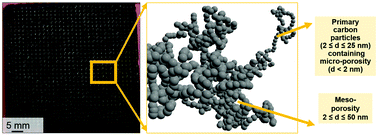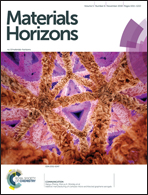Direct ink writing of organic and carbon aerogels†
Abstract
The use of additive manufacturing to 3D print aerogels has the potential to impact several important technologies such as energy storage, catalysis, and desalination. While there has been a great deal of focus on graphene aerogels, reports of 3D printed conventional carbon aerogels (CAs) are sparse. Activated CAs are particularly compelling because in addition to having a lower cost than a comparable graphene aerogel, they can achieve much higher surface areas (>3000 m2 g−1). Herein we report a 3D printable ink based on traditional resorcinol–formaldehyde sol–gel chemistry that can produce a final activated carbon aerogel with surface areas approaching 2000 m2 g−1 and good electrical conductivities (∼200 S m−1). Direct ink writing (DIW) is used to then fabricate electrodes, which demonstrate excellent electrochemical properties with a high specific capacitance of 215 F g−1 at 1 A g−1 and 83% capacitive retention at higher current densities (10 A g−1). The DIW electrode significantly outperformed its bulk counterpart and provides an example of how one can use 3D printed aerogel electrodes to overcome mass transport limitations and boost energy storage performance.



 Please wait while we load your content...
Please wait while we load your content...